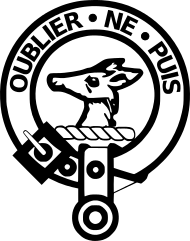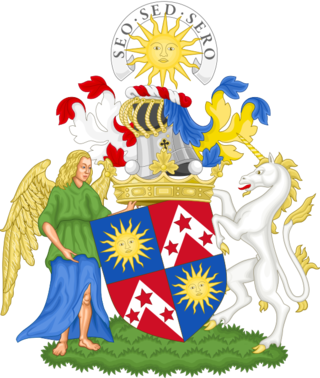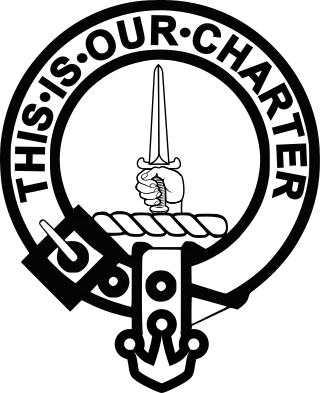| Clan Colville | |||
|---|---|---|---|
 | |||
| Motto | Oblier ne puis (I cannot forget) [1] | ||
| Chief | |||
 | |||
| Charles Colville | |||
| The Rt Hon The Viscount Colville of Culross | |||
| Historic seat | Kinnaird Castle | ||
| |||
Clan Colville is a Lowland Scottish clan. [2]
| Clan Colville | |||
|---|---|---|---|
 | |||
| Motto | Oblier ne puis (I cannot forget) [1] | ||
| Chief | |||
 | |||
| Charles Colville | |||
| The Rt Hon The Viscount Colville of Culross | |||
| Historic seat | Kinnaird Castle | ||
| |||
Clan Colville is a Lowland Scottish clan. [2]

The Clan Colville chiefs are of ancient Norman origin. [2] The name is probably derived from the town of Colville in Normandy. [2] The first of the name to appear in Scotland was Philip de Colville who is found as a witness to a charter to Dunfermline Monastery some time before 1159. [2] In 1174 Phillip de Colville was one of the hostages used for the release of William the Lion under the Treaty of Falaise. [2] Phillip was also granted the baronies of Oxnam and Hecton in Roxburghshire as well as lands in Ayrshire. [2] Phillip's son was Thomas de Colville who between 1189 and 1199 was a witness to several charters of William the Lion. [2] Thomas was unjustly suspected of treason and was imprisoned in Edinburgh Castle but he later regained royal favor and died on his own estates in 1219. [2] Thomas's son was William de Colville who acquired the barony of Kinnaird in Stirlingshire which remains the chief's seat to this day. [2] In 1228 William de Colville granted a lease of the part of his barony to the Abbot of Holyrood which was confirmed in a charter by Alexander II of Scotland. [2]
The heiress of Sir William Colville was E'stace. [2] She was married to Sir Reginald Cheyne, an elderly knight who died in about 1291, leaving her considerable wealth. [2] E'stace appears on the Ragman Rolls of 1296 swearing fealty to Edward I of England. [2] She is recorded on the Ragman Rolls as holding lands in Aberdeen, Ayr, Banff, Forfar, Inverness and Kincardine. [2] The foundation of the fortunes of the Colvilles is attributed to E'stace's considerable abilities by Alexander Nisbet. [2]
A grant made to Melrose Abbey by E'stace de Colville was confirmed in 1324 by Robert Colville who is described as Baro baronial de Ochiltree which means Baron of the barony of Ochiltree. [2] The baron made donations to the monks of Kelso Abbey and his barony of Ochiltree was confirmed by David II of Scotland in 1350. [2]
In 1436 Thomas Colville of Oxnam, who was probably Robert's grandson, was selected to accompany Princess Margaret, daughter of James I of Scotland for her marriage to the Dauphin of France, later Louis XI of France. [2] Robert Colville had also been one of the hostages for the release of James I from English captivity four years earlier. [2]
Sir Richard (or Robert Colville) killed John Auchinleck in 1449. [2] Auchinleck was a favourite of the Earl of Douglas (chief of Clan Douglas) and to avenge Auchinleck's fate, Douglas laid waste to all of the lands that belonged to Colville and besieged and took his Kinnaird Castle, with a great loss of life. [2]
In 1513 Robert Colville of Hilton was killed at the Battle of Flodden. [2] His son was Sir James Colville of Ochiltree who in 1527 was appointed to the office of Comptroller of the Royal Household. [2] In 1530 he exchanged his lands of Ochiltree for the lands of East Wemyss and Lochorshyre with Hamilton of Finnart. [2] He was appointed a judge of the Supreme Court as Sir James Colville of Easter Wemyss. [2] However he was later accused of treason and his estates were annexed by the Crown, but in 1543 the forfeiture was recalled. [2]
Sir James Colville, third of Easter Wemyss was a distinguished soldier who fought in France for the Prince of Navarre, later Henry IV of France. [2] In 1582 he returned to Scotland with Francis Stewart, 5th Earl of Bothwell, loaded with commendations from his French patrons. [2] In 1604 Sir James Colville was raised in the peerage with the title 'Lord Colville of Culross', which the chiefs still bear today. [2] The second Lord Colville died without issue in 1640 leaving the title to his cousin as heir. [2] However his cousin did not assume the title and it remained dormant until 1723. [2]
In 1709 John Colville, de jure seventh Lord Colville, served as a soldier at the Battle of Malplaquet which was a great victory for John Churchill, 1st Duke of Marlborough. [2] He was made heir to the second Lord Colville in 1722, but a petition to the king claiming the Peerage was referred to the House of Lords for an enquiry. [2] In 1723 the House found in favour of Colville, who was placed on the Roll of Peers. [2] He continued his military career and commanded a battalion at the siege of Cartagena, where he died in 1741. [2] Colville left a large family who all had successful military careers. [2]
During the Jacobite rising of 1745 Charles Colville supported the British Government and commanded the 21st Regiment of Foot (Royal Scots Fusiliers) at the Battle of Culloden in 1746. [2] He died in 1775 having achieved the rank of lieutenant general. [2]
In 1731 Alexander Colville, 7th Lord Colville of Culross joined the Navy. [2] He soon obtained his own command and by in 1744 became captain of HMS Leopard (1741), a fifty gun frigate. [2] He was later promoted to commodore and obtained command of HMS Northumberland (1750) and sailed to America in 1755 during the Seven Years' War. [2] In 1759 Colville forced the French to raise the siege of Quebec and retreat. [2] In 1769 Colville was promoted to the rank of Vice Admiral. [2]
Charles Colville served with distinction during the Peninsular War and also at the Battle of Waterloo. [2] His two elder brothers died without issue and so his son, Charles Colville, 1st Viscount Colville of Culross, succeeded to the peerage. [2] This Charles Colville was Chief Equerry to Queen Victoria and Lord Chamberlain to Queen Alexandra of Denmark. He was created Viscount Colville of Culross in 1902. [2]
The brother of the second Viscount was Sir Stanley Colville who was rear admiral and commander in chief at Portsmouth between 1916 and 1919. Stanley Colville received some of the country's highest honors, including Grand Cross of the Order of the Bath. [2]
Mark Colville, 4th Viscount Colville of Culross, gained the title in 1945, and served as a Home Office Minister under Edward Heath and was a member of the UN Human Rights Commission. He died in 2010 and was succeeded by his son, Charles Colville, 5th Viscount Colville of Culross, a member of the House of Lords who is currently the Clan Chief.

Marquess of Lothian is a title in the Peerage of Scotland, which was created in 1701 for Robert Kerr, 4th Earl of Lothian. The Marquess of Lothian holds the subsidiary peerages of Earl of Lothian, Earl of Ancram, Viscount of Briene (1701), Lord Newbattle (1591), Lord Jedburgh (1622), Lord Kerr of Newbattle (1631), Lord Kerr of Nisbet, Langnewtoun, and Dolphinstoun (1633), Lord Kerr of Newbattle, Oxnam, Jedburgh, Dolphinstoun and Nisbet (1701), and Baron Ker, of Kersheugh in the County of Roxburgh (1821), all but the last in the Peerage of Scotland. As The Lord Ker in the Peerage of the United Kingdom, previous marquesses sat in the House of Lords before 1963, when Scottish peers first sat in the House of Lords in their own right. The holder of the marquessate is also the Chief of Clan Kerr.
Viscount Colville of Culross, in the County of Perth, is a title in the Peerage of the United Kingdom. It was created on 15 July 1902 for the politician and courtier, Charles Colville, 10th Lord Colville of Culross. He had already been created Baron Colville of Culross, in the County of Perth, in 1885, also in the Peerage of the United Kingdom. As of 2018, the titles are held by his great-great-grandson, the fifth Viscount, who succeeded his father in 2010. The fourth Viscount was a judge and politician. Lord Colville of Culross was one of the ninety elected hereditary peers that remained in the House of Lords after the passing of the House of Lords Act 1999, and sat as a crossbencher.

Charles John Colville, 1st Viscount Colville of Culross,, known as The Lord Colville of Culross between 1849 and 1902, was a British nobleman, Conservative politician, courtier, and painter.

Clan Carnegie is a Lowland Scottish clan.

Clan Charteris is a Scottish clan of the Scottish Lowlands.

Clan Cochrane is a Scottish clan of the Scottish Lowlands.

Clan Crichton is a Lowland Scottish clan that historically ruled Dumfries.

Clan Cranstoun is a family of the Scottish Lowlands.

Clan Erskine is a Scottish clan of the Scottish Lowlands.

Clan Ogilvy, also known as Clan Ogilvie, is a Highland Scottish clan. Originating from Angus, Scotland, the progenitor of the Clan received a barony from King William the Lion in 1163. In 1491, King James IV elevated Sir James Ogilvy as Lord Ogilvy of Airlie.

Clan Haldane is a Lowland Scottish clan.

Clan Hannay is a Lowland Scottish clan.

Clan Primrose is a Lowland Scottish clan.

Clan Spens or Spence is a Lowland Scottish clan and is also a sept of Clan MacDuff.

Clan Wemyss is a Lowland Scottish clan.
James Colville, 1st Lord Colville of Culross (1551–1629) was a Scottish soldier, courtier, and diplomat.

Baron of Plenderleith is an ancient title of nobility in the Baronage of Scotland.

Charles Mark Townshend Colville, 5th Viscount Colville of Culross, is a Scottish television producer, director and hereditary peer.

Ochiltree Castle was a castle built on a promontory by the Lugar Water, East Ayrshire, Scotland across from Auchinleck Castle. Built by the de Colville family in the 12th century, it was destroyed in 1449, by Sir William Douglas.
Sir James Colville of Easter Wemyss was a Scottish administrator, lord of session and diplomat.